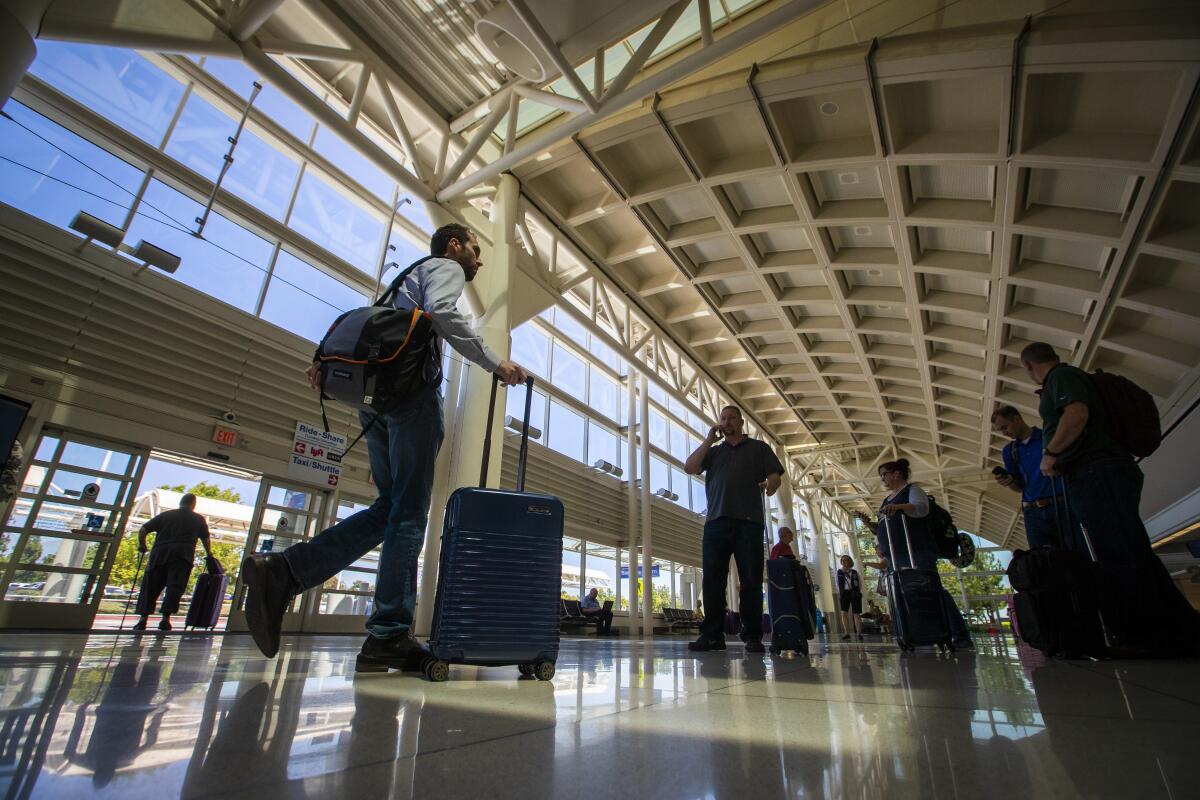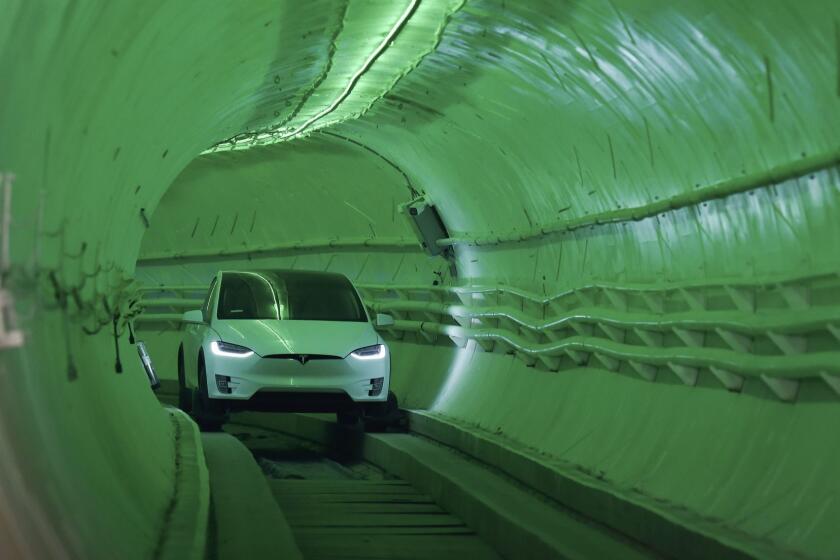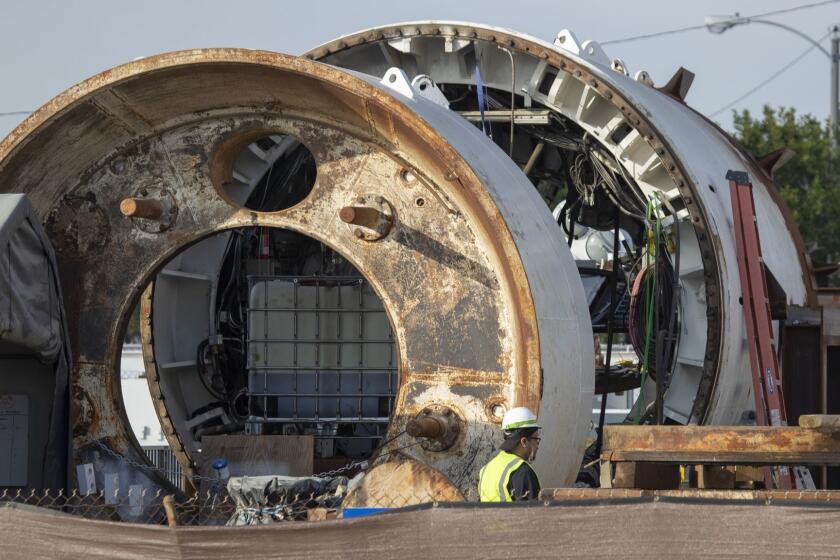Elon Musk abandoned plans for a four-mile tunnel at Ontario airport. Locals are picking it up

- Share via
Five years ago, tech mogul Elon Musk posited a way to curtail rush-hour traffic in Southern California: Build high-speed underground tunnels.
Among those plans, Musk’s civil engineering firm, the Boring Co., submitted an unsolicited proposal in 2019 to the San Bernardino County Transportation Authority for a tunnel that would whisk riders from the Rancho Cucamonga Metrolink station to Ontario International Airport in just a few minutes.
The proposed subterranean path would run in one direction and cost less than $100 million — a far cry from the more than $1-billion price tag for a surface-level connection system, according to the county transportation agency’s spokesperson, Tim Watkins.
It piqued the group’s interest, and its board of directors backed the idea, voting in 2020 to pursue the project.
Since then, Musk and his company have backed out of the project, Watkins said — but that isn’t stopping the transportation authority.
“This is still a viable project, and we’re moving forward,” Watkins said last week.
Billionaire entrepreneur Elon Musk’s plan to help drivers escape traffic by sending cars hurtling through dozens of skinny tunnels has caught the imagination of some Californians who are sick of gridlock but unwilling to give up their vehicles.
The plan, which will now feature two tunnels stretching 4.2 miles for travel in both directions, is estimated to cost roughly $492 million and is expected take riders to their destination in less than 10 minutes, Watkins said.
Three above-ground stations will be built — one at the Rancho Cucamonga train station and two at the Ontario airport at Terminals 2 and 4. The San Bernardino County Transportation Authority plans to cover nearly half the cost and is looking to close financing gaps through grants and state and federal dollars. Service could start as early as 2027, officials said.
The agency decided to take on a “more traditional process for the environmental clearance” of the tunnel by having a third party assess potential impacts of the project and asking the Boring Co. to submit another proposal by the end of January 2022, Watkins said. But that deadline came and went and Musk’s company didn’t respond, effectively making a “business decision not to continue down that path,” he said.
This is not the first time Musk has backed out of a tunnel project. In 2018, he announced plans to build two tunnels in Los Angeles: one that would run beneath Sepulveda Boulevard on the Westside and another between a Metro station on Vermont Avenue and Dodger Stadium. After two groups sued over the city’s proposal to exempt the Sepulveda Boulevard tunnel from an environmental review, Musk said his company was no longer pursuing the project. The Dodger Stadium tunnel also was quietly removed from the Boring Co.’s website.
Musk’s company unveiled its first high-speed tunnel in 2018, a 1.14-mile route beneath Hawthorne that took about 18 months and $10 million to construct. In 2019, the Boring Co. also inked a $48.7-million contract to build an underground transit loop for the Las Vegas Convention Center.
Watkins declined to comment on the firm’s decision about the Ontario tunnel and referred further questions to Musk and the Boring Co. Neither responded to repeated requests for comment.
On a misty night last week, the growl of heavy machinery and white-hot glare of floodlights were the only indications that engineers working for billionaire Elon Musk were digging a tunnel beneath the city of Hawthorne.
But he said the county applauds the “innovative thinking” from the Boring Co. to bring up new, innovative solutions to existing challenges,” Watkins said. “We can see there’s real value to a sub-surface connection. This is the fastest-growing airport in the country, and not only does [a tunnel] address the need for transit options for a growing airport, but we want to make sure we get ahead of traffic impacts for the communities that surround the airport.”
Ontario International Airport CEO Atif Elkadi said the tunnel is a creative solution to enhance transportation connections to the airport.
But the project still has a long way to go. The agency has to secure at least $265 million from the state and $25 million in federal funding. An underground tunnel is also an unprecedented feat in an area infamous for traffic congestion. The project’s design and building could take up to three years before it’s ready for testing.
In April, the San Bernardino County Transportation Authority began obtaining environmental clearance and drafting a formal document for the Ontario airport tunnel, a process that typically takes around 18 months. The agency also is conducting industry outreach and courting new firms to help with financing as well as design and construction. Outside companies will be required to submit their own proposals for approval.
The Ontario airport is one of the fastest-growing in the country. Passenger totals increased nearly 7% between April 2019 and April 2022, surpassing pre-pandemic levels, according to the county’s transportation agency.
“On the upside for SBCTA, the Boring Co. has acted as such a disrupter in the market that other companies are stepping up with innovative ideas and reduced pricing, and they’re interested in these projects they may not have been interested in before,” San Bernardino County Supervisor Janice Rutherford said. “We’re excited to see which would be a good solution for our residents who want to get to the airport.”
The agency is also reaching out to the public for feedback on the project and to assess potential concerns, including how often the service will run, compliance with the Americans with Disabilities Act, as well as seismic and utility issues.
Reaction has been mixed. San Bernardino resident Marven Norman criticized the plan at a recent public forum, saying the project is squandering opportunities to build other stations along the line.
“On one hand, it’s exciting to see that something is finally moving forward. On the other hand, it’s disappointing to see that this is what’s moving forward,” he said. “Pretty much all of these studies identified intermediate stations between where the transit would leave the Metrolink line and get to the airport, and this one has none, even though it goes past the mall, an office, the arena, etc.
“It’s meeting the goal of going between the train station and the airport and only that, and in the process, it’s leaving a lot of potential uses in the wayside,” he added.
Still, Bud Weisbart called the project “exciting” and said there is a “tremendous ‘wow’ factor.” But he did ask whether alternative measures were studied.
The county’s transportation agency is looking into self-driving electric vehicles that will be sized to accommodate luggage, as well as shuttles for the tunnels, but it has yet to finalize details. It also hasn’t figured out how fast the autonomous vehicles will travel or how often service will run. The group plans to bring on a team to get service started around fall 2027, and then Omnitrans, which operates all buses in San Bernardino, will take over long-term operations.
“It’s a cool project,” Watkins said. “We’re very excited about bringing another innovative solution to transportation and finding new ways to address old challenges.”
More to Read
Sign up for Essential California
The most important California stories and recommendations in your inbox every morning.
You may occasionally receive promotional content from the Los Angeles Times.













